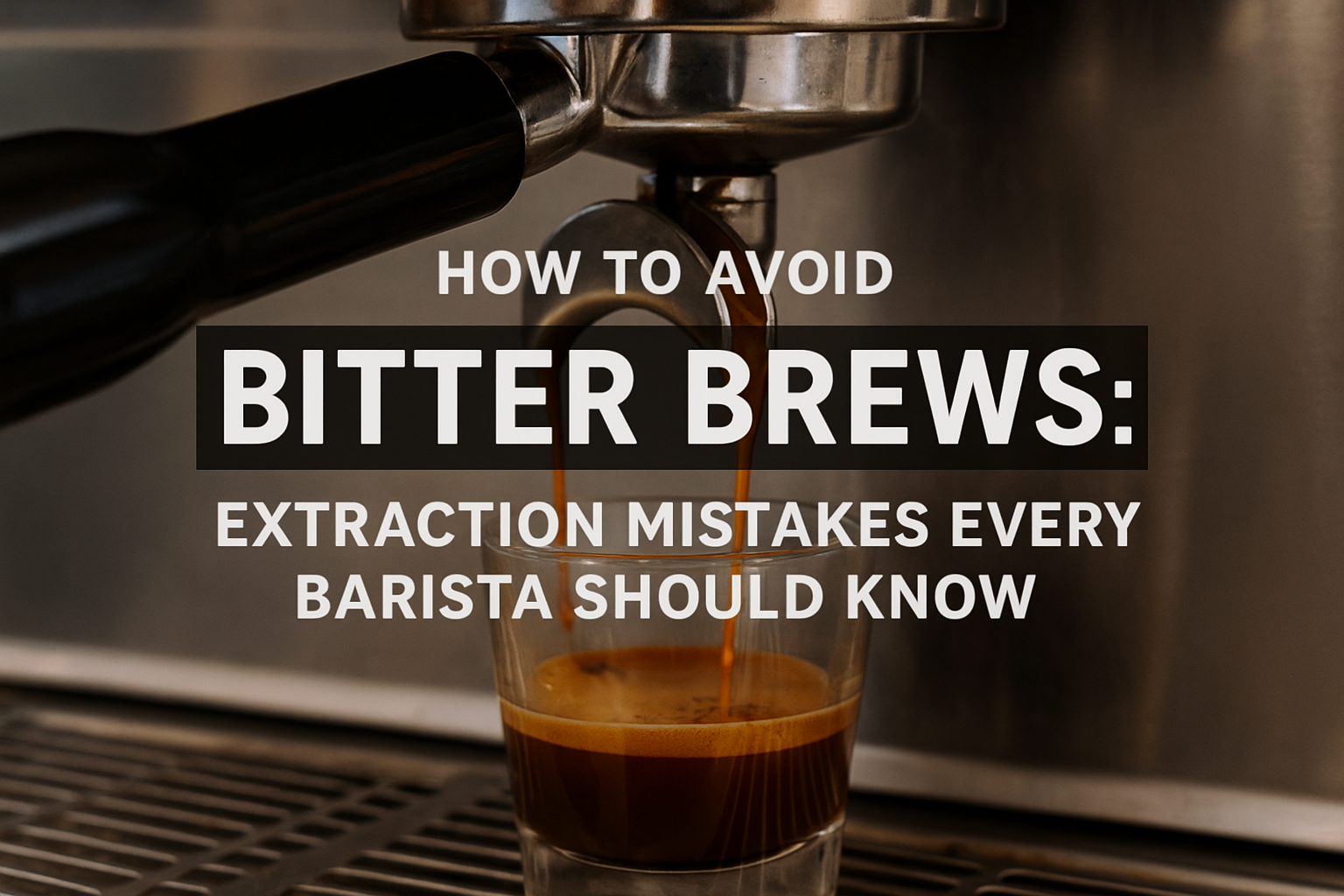There’s nothing worse than taking a sip of espresso and being hit with an unpleasant bitterness. While some bitterness is a natural part of coffee’s flavor profile, an overly bitter brew usually means something went wrong during the extraction process.
For beginner baristas, understanding how extraction works is one of the most important parts of mastering espresso. Fortunately, bitter brews can often be fixed by identifying a few key mistakes.
In this article, you’ll learn what causes bitterness in espresso, how to fix it, and how to consistently pull balanced, flavorful shots.
What Is Extraction, Really?
Extraction is the process of dissolving soluble compounds from ground coffee into water. When you brew espresso, hot water passes through the compacted coffee puck in the portafilter and pulls out oils, acids, sugars, and other flavors.
But not all compounds extract at the same rate:
- First come the acids – bright, fruity, and floral notes
- Then come the sugars – sweetness and body
- Last come the bitter compounds – tannins and unwanted notes
This means if you extract too much, bitterness dominates the cup. The goal is to stop the shot when the best balance of acids, sugars, and mild bitters has been reached.
Over-Extraction: The Main Cause of Bitterness
Bitterness is often caused by over-extraction, which means you’re pulling too much from the coffee grounds. When water stays in contact with the coffee for too long, it pulls out undesirable flavors.
Common causes of over-extraction include:
- Grind too fine
- Tamp too hard
- Too much coffee in the basket
- Shot time too long
- Water temperature too high
Let’s break each one down.
Mistake #1: Grinding Too Fine
When your grind is too fine, water has a hard time flowing through the coffee puck. It takes longer to pass, increasing contact time — which means more extraction and, you guessed it, more bitterness.
Symptoms:
- Shots take longer than 30 seconds
- Espresso looks thin and dribbles slowly
- Strong bitter aftertaste
Fix it:
- Adjust your grinder to a slightly coarser setting
- Time your shot (ideal range: 25–30 seconds for a double)
- Monitor flow rate and crema texture
A good espresso should have a steady, honey-like flow and a thick, golden crema.
Mistake #2: Over-Tamping
Tamping too hard compresses the coffee too tightly, restricting water flow — similar to grinding too fine. Water struggles to pass through the puck, resulting in over-extraction.
Symptoms:
- High pressure on the machine
- Slow, uneven shots
- Bitter and sharp flavor
Fix it:
- Apply firm but moderate pressure when tamping
- Focus on level, even compression, not brute strength
- Combine with the right grind size for balance
Remember: tamping isn’t about how strong you are, but how consistent and controlled you can be.
Mistake #3: Overdosing the Portafilter
More coffee doesn’t always mean better espresso. Adding too much coffee to the basket increases puck density, slowing down the water flow and causing over-extraction.
Symptoms:
- Portafilter won’t lock in easily
- Coffee puck sticks to group head
- Bitter, strong taste with harsh finish
Fix it:
- Weigh your dose (usually 18–20g for a double shot)
- Use the correct basket size
- Adjust the grinder to match the dose and tamping pressure
Precision in dosing is key. A few grams can make a big difference.
Mistake #4: Letting the Shot Run Too Long
Timing is everything. If your shot runs longer than 30–35 seconds, you’re likely pulling bitter compounds that should’ve stayed in the puck.
Symptoms:
- Long, watery shots
- Espresso tastes hollow and bitter
- Lingering unpleasant aftertaste
Fix it:
- Start timing shots consistently
- Adjust grind to control shot length
- Cut the shot between 25–30 seconds when the flow starts to blonde (lighten)
Use a timer or the built-in shot timer on your espresso machine. The difference in taste is immediate.
Mistake #5: Water Too Hot
Water temperature directly affects extraction. If the water is too hot (above 96°C / 205°F), it over-extracts bitter compounds quickly.
Symptoms:
- Coffee tastes burnt or smoky
- Bitter from the first sip
- Shot smells overly roasted or “ashy”
Fix it:
- Check your machine’s temperature settings
- Aim for a range of 90–96°C (195–205°F)
- If unsure, ask a manager or technician to verify calibration
Even if you’re doing everything else right, overheating can sabotage your espresso.
Other Causes of Bitterness
Bitterness isn’t always about over-extraction. There are other factors that contribute to an unpleasant taste in coffee.
Low-Quality or Over-Roasted Beans
Dark roasts naturally have more bitterness. If your beans are over-roasted or stale, no amount of perfect brewing will fix the taste.
Look for:
- Shiny, oily beans
- Smoky smell
- Beans older than 3–4 weeks after roast date
Whenever possible, use fresh, high-quality specialty beans. They offer more complexity and sweetness.
Dirty Equipment
Old coffee oils and residue inside your group head, portafilter, or grinder can introduce bitterness into your brew.
Keep everything clean:
- Backflush daily with water and weekly with cleaner
- Scrub the group head
- Rinse and wipe portafilters between shots
- Clean your grinder regularly (as covered in a previous article)
A clean machine equals clean coffee flavor.
Channeling During Extraction
Channeling happens when water finds cracks or weak spots in the puck, extracting unevenly — some parts under-extracted, others over-extracted.
Causes:
- Uneven tamping
- Poor distribution of grounds
- Cracked or collapsed puck
Fix it:
- Use a distribution tool or finger swipe method
- Tamp level and evenly
- Practice removing and reinserting the portafilter carefully
Channeling is often invisible but very noticeable in taste.
How to Know If Bitterness Is Normal or a Mistake
Some bitterness is expected — especially in espresso. The trick is to recognize when it’s excessive or imbalanced.
Balanced bitterness:
Adds depth, rounds out sweetness, and lingers gently.
Unpleasant bitterness:
Dominates the cup, overwhelms other flavors, leaves a dry or harsh aftertaste.
When tasting, ask:
- Is the shot also sweet or acidic?
- Does the bitterness fade smoothly or cling to the tongue?
- Would a customer enjoy this, or wince at the finish?
Developing your palate takes time, but with practice, you’ll learn to detect when your extraction has gone too far.
Tips for Consistently Delicious Espresso
Here are five habits to help you avoid bitter brews:
- Dial in your grinder daily
Coffee changes throughout the day due to humidity, freshness, and usage. - Taste your shots
When allowed, taste what you serve. Your palate is your best tool. - Watch the flow
A beautiful espresso should have a smooth, steady stream — not dripping or gushing. - Keep a brew log
Track your grind size, dose, time, and taste notes. Patterns will emerge. - Ask for feedback
Learn from experienced baristas and don’t be afraid to say, “Can you taste this and help me improve?”
Bitterness Isn’t a Mystery — It’s a Message
When your espresso tastes bitter, it’s trying to tell you something. Maybe your grind is too fine, your tamp too heavy, or your shot too long. Whatever the reason, the good news is: it’s fixable.
Baristas aren’t just following steps. They’re reading the signs, making adjustments, and constantly improving. Bitterness is part of the process — but it shouldn’t be the main character in your cup.
Pay attention to the details, stay curious, and never stop dialing in. Every great shot begins with understanding the science of extraction.
Next up:

Marcelo Rodrigues is a passionate barista with over 7 years of experience in specialty coffee. He’s worked in top cafés, led barista training sessions, and now shares practical tips to help beginners and coffee lovers improve their skills. Through this blog, Marcel makes the world of coffee more accessible—one cup at a time.

